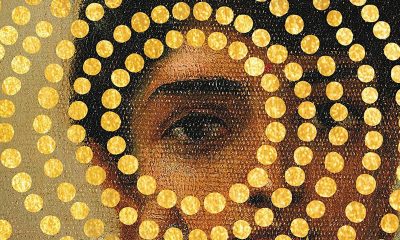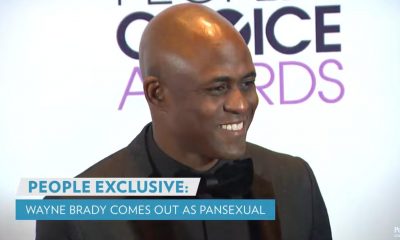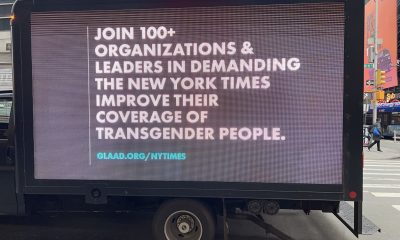Books
YEAR IN REVIEW 2016: Books
Haunting Dust Bowl novel by Annie Bell among year’s best books
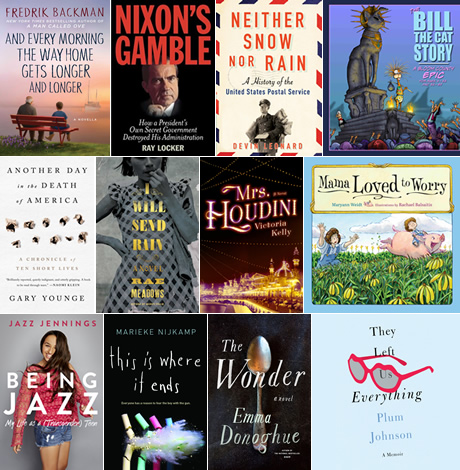
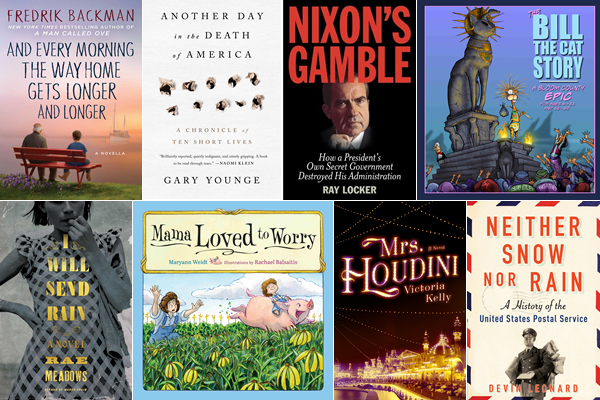 I’m not sure why, but I couldn’t stop touching “I Will Send Rain” by Rae Meadows when I first got it. The cover pulled at me, but the story? Oh my, it’s the tale of a family of four during the Dust Bowl years. The mother, Annie Bell, is trying desperately to hold her family together while her daughter dreams a dangerous dream, her son is mute and her husband slowly goes mad. There’s a surprise in here, a fifth main character, and that’s the dust. Do. Not. Miss. This. Book.
I’m not sure why, but I couldn’t stop touching “I Will Send Rain” by Rae Meadows when I first got it. The cover pulled at me, but the story? Oh my, it’s the tale of a family of four during the Dust Bowl years. The mother, Annie Bell, is trying desperately to hold her family together while her daughter dreams a dangerous dream, her son is mute and her husband slowly goes mad. There’s a surprise in here, a fifth main character, and that’s the dust. Do. Not. Miss. This. Book.
Not normally a big fan of fictionalized biographies, “Mrs. Houdini” by Victoria Kelly nonetheless captivated me with its magic. It’s a tale of love and illusion, believing, trust, and it includes a gauzy ending that might seem implausible but who knows? Hint: if you can bear it, save your gift card. This book comes out in paperback in March.
Generally speaking, I’ll read anything by out author Emma Donoghue. She has a way of turning a tiny, true event into a novel that sticks in your head and “The Wonder” is no exception. It’s the story of a very confident, almost haughty nurse who served with Florence Nightingale and seems to think that stint confers some sort of specialness. When she’s hired to watch a child who claims not to eat or drink, the nurse thinks the girl is a scammer, but, of course, there’s so much more to the story and an ending that’s so perfect, it’s stunning. Write this title down. It’s another book you can’t miss.
A vision of the apocalypse is at root in “The Fireman” by Joe Hill. It’s a novel about a virus that’s infected the world, and if you catch it, you burn. Poof, up in flames, and it’s pitting neighbor against neighbor and husband against wife. There’s a surprising romance in this book, thrills, a chase, humor and horror, and here’s a hint: there are shades of Hill’s father in here. Guess who?
For my fifth pick, I debated: “Britt-Marie Was Here” or “And Every Morning the Way Home Gets Longer and Longer,” both by Fredrik Backman? I finally decided on the latter, the story of life and loss, forgetting and trying hard not to. But here’s the thing to know: the first go-around won’t make much sense. Turn around and read it again — it’s really short, so no problem — and bring tissues that time. It’s truly a lovely book.
Hint: “Britt-Marie” is a close, very close second-pick.
NONFICTION
As I was looking over the list of things I read, I was surprised to remember how much I enjoyed “Neither Snow nor Rain” by Devin Leonard. Overall, this book is about the U.S. Postal Service and its history. The thing that makes this book so much fun, though, is that Leonard also includes so many side stories that it becomes more of a general history that’s light and fun. Fans of Bill Bryson, take note and find this book.
Another something that’s informative and a little on the light side is “Playing Dead” by Elizabeth Greenwood. I mean, how many times a week does the average person wish they could chuck it all and disappear somewhere? Greenwood looks into that: how it’s done, what it’s like and the impacts it has on loved ones. You might change your mind. Or you might want to disappear even more. Either way, this is a can’t miss.
As a Baby Boomer, “They Left Us Everything” by Plum Johnson particularly resonated with me, which is why it really has to be on this list. Johnson’s parents were both elderly and had lived in their oversized house for decades. When they died in relatively fast succesion, Johnson and her brothers were tasked with cleaning up, but not just the house. They also had memories to examine and scrub. This is a book for daughters, particularly, but also for anyone who’s facing the downsizing of a home or end-of-life caretaking.
In a political year, you might guess that an abundance of political books might be published, and you’d be right. My pick for the best in that category is “Nixon’s Gamble” by Ray Locker, who takes a brief look at Nixon’s early career before digging into the moves that the President made, starting on the day of his inauguration. Even if you think you know what happened nearly half a century ago, you don’t. For history lovers of any age or place, this is an eye-opener.
I don’t think I would have liked “Another Day in the Death of America” by Gary Younge quite as much if it had been laser-focused. Nope, Younge took one random day in recent years, and he writes about the 10 children who died of gunshot wounds in the U.S. on that day. It’s that randomness that’s so shocking, especially when you consider the statistic he cites: an average of seven children die by gun every day in America. The circumstances Younge found make this book even more impactful.
CHILDREN’S/YOUNG ADULT BOOKS
Putting “The Bill the Cat Story” by Berkley Breathed on the kids best of list might be cheating a little because this book is only partly something for kids. True, the kiddoes will love the illustrations and older children might laugh at the storyline, but this book is every bit for adults as it is for the younger set. Grown-ups will love the message inside this book; fans of Breathed’s “Bloom County” will appreciate knowing about Binkley’s first days with Bill, and the insider peek at Opus’ home. I don’t say this lightly: it’s a book for the whole family.
I’m not sure if I was ready for its light breeziness, but “Being Jazz” by Jazz Jennings was the right book at the right time when I read it last summer. You might have seen Jennings on the news; as a transgender teen, she’s become somewhat of a spokesperson for trans rights and acceptance. Her book is gossipy, bubbly and truthful — she proactively answers questions that teens want to know, without embarrassment. Hint: this is a great book for adults, too.
Another book that caught me by surprise (because I loved it so much) was “Mama Loved to Worry” by Maryann Weidt, illustrated by Rachael Balsaitis. In the same vein as the Pecos Bill, Slue-Foot Sue and Paul Bunyan stories you loved as a kid, this is a book set on a farm, with a Mama whose tasks grow larger in both action and in fable. The pictures are as much fun as the story, and you’ll love it just as much as does your child, especially when it’s read aloud.
There’s a lot of cleverness inside “The Night Parade” by Kathryn Tanquary — enough to keep a lover of darkness up all night. It’s the story of a Japanese-American girl who tries to fit in with the “in” crowd by disrespecting her ancestors, and yes, her actions have scary repercussions. Older middle schoolers not prone to nightmares will love this, as will younger young adults who are just stepping into this genre. Hint: save your gift cards. This book comes out in paperback in January.
And finally, “This is Where It Ends” by Marieke Nijkamp is a chillingly unexpected tale of a school shooting and heroism, with realism and timeliness that will shock you. That’s not counting the story itself, told in minute-by-minute increments that will make you forget you’re not reading a real account of a tragedy. Again, this isn’t just a YA book. It’s something adults should also want to read.

This past year, you’ve often had to make do.
Saving money here, resources there, being inventive and innovative. It’s a talent you’ve honed, but isn’t it time to have the best? Yep, so grab these Ten Best of 2025 books for your new year pleasures.
Nonfiction
Health care is on everyone’s mind now, and “A Living: Working-Class Americans Talk to Their Doctor” by Michael D. Stein, M.D. (Melville House, $26.99) lets you peek into health care from the point of view of a doctor who treats “front-line workers” and those who experience poverty and homelessness. It’s shocking, an eye-opening book, a skinny, quick-to-read one that needs to be read now.
If you’ve been doing eldercare or caring for any loved one, then “How to Lose Your Mother: A Daughter’s Memoir” by Molly Jong-Fast (Viking, $28) needs to be in your plans for the coming year. It’s a memoir, but also a biography of Jong-Fast’s mother, Erica Jong, and the story of love, illness, and living through the chaos of serious disease with humor and grace. You’ll like this book especially if you were a fan of the author’s late mother.
Another memoir you can’t miss this year is “Between the Devil and the Deep Blue Sea: A Veteran’s Memoir” by Khadijah Queen (Legacy Lit, $30.00). It’s the story of one woman’s determination to get out of poverty and get an education, and to keep her head above water while she goes below water by joining the U.S. Navy. This is a story that will keep you glued to your seat, all the way through.
Self-improvement is something you might think about tackling in the new year, and “Replaceable You: Adventures in Human Anatomy” by Mary Roach (W.W. Norton & Company, $28.99) is a lighthearted – yet real and informative – look at the things inside and outside your body that can be replaced or changed. New nose job? Transplant, new dental work? Learn how you can become the Bionic Person in real life, and laugh while you’re doing it.
The science lover inside you will want to read “The Grave Robber: The Biggest Stolen Artifacts Case in FBI History and the Bureau’s Quest to Set Things Right” by Tim Carpenter (Harper Horizon, $29.99). A history lover will also want it, as will anyone with a craving for true crime, memoir, FBI procedural books, and travel books. It’s the story of a man who spent his life stealing objects from graves around the world, and an FBI agent’s obsession with securing the objects and returning them. It’s a fascinating read, with just a little bit of gruesome thrown in for fun.
Fiction
Speaking of a little bit of scariness, “Don’t Forget Me, Little Bessie” by James Lee Burke (Atlantic Monthly Press, $28) is the story of a girl named Bessie and her involvement with a cloven-hooved being who dogs her all her life. Set in still-wild south Texas, it’s a little bit western, part paranormal, and completely full of enjoyment.
“Evensong” by Stewart O’Nan (Atlantic Monthly Press, $28) is a layered novel of women’s friendships as they age together and support one another. The characters are warm and funny, there are a few times when your heart will sit in your throat, and you won’t be sorry you read it. It’s just plain irresistible.
If you need a dark tale for what’s left of a dark winter season, then “One of Us” by Dan Chaon (Henry Holt, $28), it it. It’s the story of twins who become orphaned when their Mama dies, ending up with a man who owns a traveling freak show, and who promises to care for them. But they can’t ever forget that a nefarious con man is looking for them; those kids can talk to one another without saying a word, and he’s going to make lots of money off them. This is a sharp, clever novel that fans of the “circus” genre shouldn’t miss.
“When the Harvest Comes” by Denne Michele Norris (Random House, $28) is a wonderful romance, a boy-meets-boy with a little spice and a lot of strife. Davis loves Everett but as their wedding day draws near, doubts begin to creep in. There’s homophobia on both sides of their families, and no small amount of racism. Beware that there’s some light explicitness in this book, but if you love a good love story, you’ll love this.
Another layered tale you’ll enjoy is “The Elements” by John Boyne (Henry Holt, $29.99), a twisty bunch of short stories that connect in a series of arcs that begin on an island near Dublin. It’s about love, death, revenge, and horror, a little like The Twilight Zone, but without the paranormal. You won’t want to put down, so be warned.
If you need more ideas, head to your local library or bookstore and ask the staff there for their favorite reads of 2025. They’ll fill your book bag and your new year with goodness.
Season’s readings!
The Blade may receive commissions from qualifying purchases made via this post.
Books
This gay author sees dead people

‘Are You There Spirit? It’s Me, Travis’
By Travis Holp
c.2025, Spiegel and Grau
$28/240 pages
Your dad sent you a penny the other day, minted in his birth year.
They say pennies from heaven are a sign of some sort, and that makes sense: You’ve been thinking about him a lot lately. Some might scoff, but the idea that a lost loved one is trying to tell you he’s OK is comforting. So read the new book, “Are You There, Spirit? It’s Me, Travis” by Travis Holp, and keep your eyes open.

Ever since he was a young boy growing up just outside Dayton, Ohio, Travis Holp wanted to be a writer. He also wanted to say that he was gay but his conservative parents believed his gayness was some sort of phase. That, and bullying made him hide who he was.
He also had to hide his nascent ability to communicate with people who had died, through an entity he calls “Spirit.” Eventually, though it left him with psychological scars and a drinking problem he’s since overcome, Holp was finally able to talk about his gayness and reveal his otherworldly ability.
Getting some people to believe that he speaks to the dead is still a tall order. Spirit helps naysayers, as well as Holp himself.
Spirit, he says, isn’t a person or an essence; Spirit is love. Spirit is a conduit of healing and energy, speaking through Holp in symbolic messages, feelings, and through synchronistic events. For example, Holp says coincidences are not coincidental; they’re ways for loved ones to convey messages of healing and energy.
To tap into your own healing Spirit, Holp says to trust yourself when you think you’ve received a healing message. Ignore your ego, but listen to your inner voice. Remember that Spirit won’t work on any fixed timeline, and its only purpose is to exist.
And keep in mind that “anything is possible because you are an unlimited being.”
You’re going to want very much to like “Are You There, Spirit? It’s Me, Travis.” The cover photo of author Travis Holp will make you smile. Alas, what you’ll find in here is hard to read, not due to content but for lack of focus.
What’s inside this book is scattered and repetitious. Love, energy, healing, faith, and fear are words that are used often – so often, in fact, that many pages feel like they’ve been recycled, or like you’ve entered a time warp that moves you backward, page-wise. Yes, there are uplifting accounts of readings that Holp has done with clients here, and they’re exciting but there are too few of them. When you find them, you’ll love them. They may make you cry. They’re exactly what you need, if you grieve. Just not enough.
This isn’t a terrible book, but its audience might be narrow. It absolutely needs more stories, less sentiment; more tales, less transcendence and if that’s your aim, go elsewhere. But if your soul cries for comfort after loss, “Are You There, Spirit? It’s Me, Travis” might still make sense.
The Blade may receive commissions from qualifying purchases made via this post.
Books
‘Dogs of Venice’ looks at love lost and rediscovered
A solo holiday trip to Italy takes unexpected turn

‘The Dogs of Venice’
By Steven Crowley
c.2025, G.P. Putnam & Sons
$20/65 pages
One person.
Two, 12, 20, you can still feel alone in a crowded room if it’s a place you don’t want to be. People say, though, that that’s no way to do the holidays; you’re supposed to Make Merry, even when your heart’s not in it. You’re supposed to feel happy, no matter what – even when, as in “The Dogs of Venice” by Steven Rowley, the Christmas tinsel seems tarnished.

Right up until the plane door closed, Paul held hope that Darren would decide to come on the vacation they’d planned for and saved for, for months.
Alas, Darren was a no-show, which was not really a surprise. Three weeks before the departure, he’d announced that their marriage wasn’t working for him anymore, and that he wanted a divorce. Paul had said he was going on the vacation anyhow. Why waste a perfectly good flight, or an already-booked B&B? He was going to Venice.
Darren just rolled his eyes.
Was that a metaphor for their entire marriage? Darren had always accused Paul of wanting too much. He indicated now that he felt stifled. Still, Darren’s unhappiness hit Paul broadside and so there was Paul, alone in a romantic Italian city, fighting with an espresso machine in a loft owned by someone who looked like a frozen-food spokeswoman.
He couldn’t speak or understand Italian very well. He didn’t know his way around, and he got lost often. But he felt anchored by a dog.
The dog – he liked to call it his dog – was a random stray, like so many others wandering around Venice unleashed, but this dog’s confidence and insouciant manner inspired Paul. If a dog could be like that, well, why couldn’t he?
He knew he wasn’t unlovable but solo holidays stunk and he hated his situation. Maybe the dog had a lesson to teach him: could you live a wonderful life without someone to watch out for, pet, and care for you?
Pick up “The Dogs of Venice,” and you might think to yourself that it won’t take long to read. At under 100 pages, you’d be right – which just gives you time to turn around and read it again. Because you’ll want to.
In the same way that you poke your tongue at a sore tooth, author Steven Rowley makes you want to remember what it’s like to be the victim of a dead romance. You can do it here safely because you simply know that Paul is too nice for it to last too long. No spoilers, though, except to say that this novel is about love – gone, resurrected, misdirected – and it unfolds in exactly the way you hope it will. All in a neat evening’s worth of reading. Perfect.
One thing to note: the Christmas setting is incidental and could just as well be any season, which means that this book is timely, no matter when you want it. So grab “The Dogs of Venice,” enjoy it twice with your book group, with your love, or read it alone.
The Blade may receive commissions from qualifying purchases made via this post.
-

 Photos5 days ago
Photos5 days agoThe year in photos
-

 Sponsored4 days ago
Sponsored4 days agoSafer Ways to Pay for Online Performances and Queer Events
-

 District of Columbia3 days ago
District of Columbia3 days agoTwo pioneering gay journalists to speak at Thursday event
-

 a&e features3 days ago
a&e features3 days agoQueer highlights of the 2026 Critics Choice Awards: Aunt Gladys, that ‘Heated Rivalry’ shoutout and more

